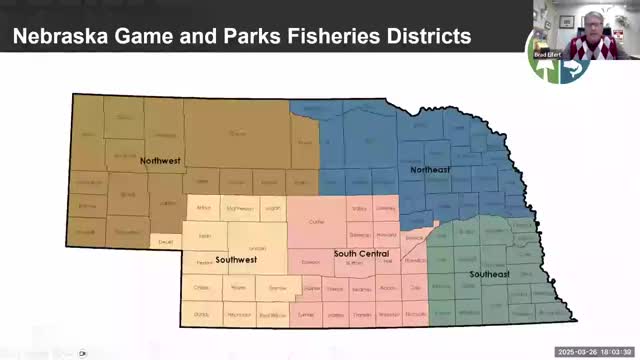Nebraska Fisheries Division increases districts to enhance angler service and management
January 01, 2025 | Nebraska Game and Parks Commission (NGPC), State Agencies, Organizations, Executive, Nebraska
This article was created by AI summarizing key points discussed. AI makes mistakes, so for full details and context, please refer to the video of the full meeting. Please report any errors so we can fix them. Report an error »

In a pivotal meeting held on January 1, 2025, the Nebraska Game and Parks Commission (NGPC) unveiled significant changes to the South-Central District's fisheries management, following a summer redistricting that expanded the number of districts from four to five. This strategic move aims to enhance customer service for anglers and streamline workloads for staff, ensuring a more balanced approach to fisheries management across the state.
The newly defined South-Central District now encompasses approximately 20 counties, integrating parts of the Northeast District, specifically Valley and Greeley counties. This reorganization is expected to improve access to the region's abundant aquatic resources, which include over 23 public water bodies totaling around 23,000 acres. Notably, the district features a mix of large irrigation reservoirs and community lakes, providing ample opportunities for fishing and recreational activities.
Among the highlights of the district are the Harlan Reservoir, the second largest in Nebraska, and several other key reservoirs like Sherman and Davis Creek, which were recently acquired through the redistricting process. These water bodies are not only vital for irrigation but also serve as popular destinations for anglers seeking a variety of fish species, including flathead catfish and sauger.
The meeting also introduced the district's dedicated team of fisheries biologists, including new hires Colton Curtis and Tyler Bennett, who bring fresh perspectives and expertise to the management efforts. Their work, alongside seasoned staff like Alex Engel, who transitioned to a role focusing on irrigation reservoir research, underscores the commitment to effective fisheries management despite a lean team.
As the meeting progressed, discussions highlighted the unique features of the district, such as the extensive Interstate 80 lake system, which offers diverse fishing opportunities and recreational activities like kayaking. With a focus on enhancing these resources, the NGPC aims to foster a thriving fishing community while ensuring sustainable practices for future generations.
The changes and updates discussed during this meeting signal a proactive approach to fisheries management in Nebraska, promising to enrich the angling experience and preserve the ecological integrity of the region's waterways. As the district moves forward, stakeholders and community members alike will be eager to see the positive impacts of these developments on local fisheries and recreational opportunities.
The newly defined South-Central District now encompasses approximately 20 counties, integrating parts of the Northeast District, specifically Valley and Greeley counties. This reorganization is expected to improve access to the region's abundant aquatic resources, which include over 23 public water bodies totaling around 23,000 acres. Notably, the district features a mix of large irrigation reservoirs and community lakes, providing ample opportunities for fishing and recreational activities.
Among the highlights of the district are the Harlan Reservoir, the second largest in Nebraska, and several other key reservoirs like Sherman and Davis Creek, which were recently acquired through the redistricting process. These water bodies are not only vital for irrigation but also serve as popular destinations for anglers seeking a variety of fish species, including flathead catfish and sauger.
The meeting also introduced the district's dedicated team of fisheries biologists, including new hires Colton Curtis and Tyler Bennett, who bring fresh perspectives and expertise to the management efforts. Their work, alongside seasoned staff like Alex Engel, who transitioned to a role focusing on irrigation reservoir research, underscores the commitment to effective fisheries management despite a lean team.
As the meeting progressed, discussions highlighted the unique features of the district, such as the extensive Interstate 80 lake system, which offers diverse fishing opportunities and recreational activities like kayaking. With a focus on enhancing these resources, the NGPC aims to foster a thriving fishing community while ensuring sustainable practices for future generations.
The changes and updates discussed during this meeting signal a proactive approach to fisheries management in Nebraska, promising to enrich the angling experience and preserve the ecological integrity of the region's waterways. As the district moves forward, stakeholders and community members alike will be eager to see the positive impacts of these developments on local fisheries and recreational opportunities.
View full meeting
This article is based on a recent meeting—watch the full video and explore the complete transcript for deeper insights into the discussion.
View full meeting
